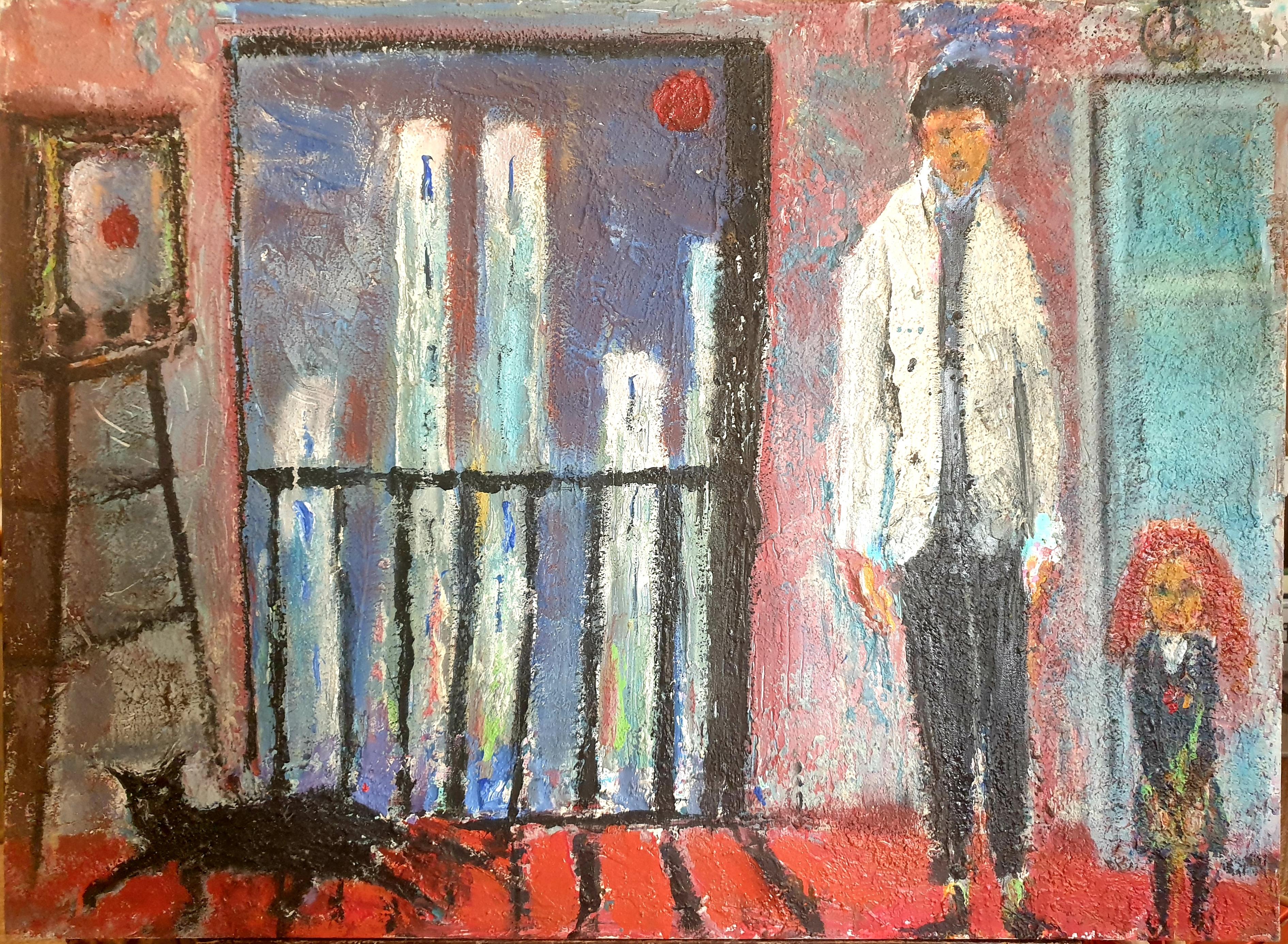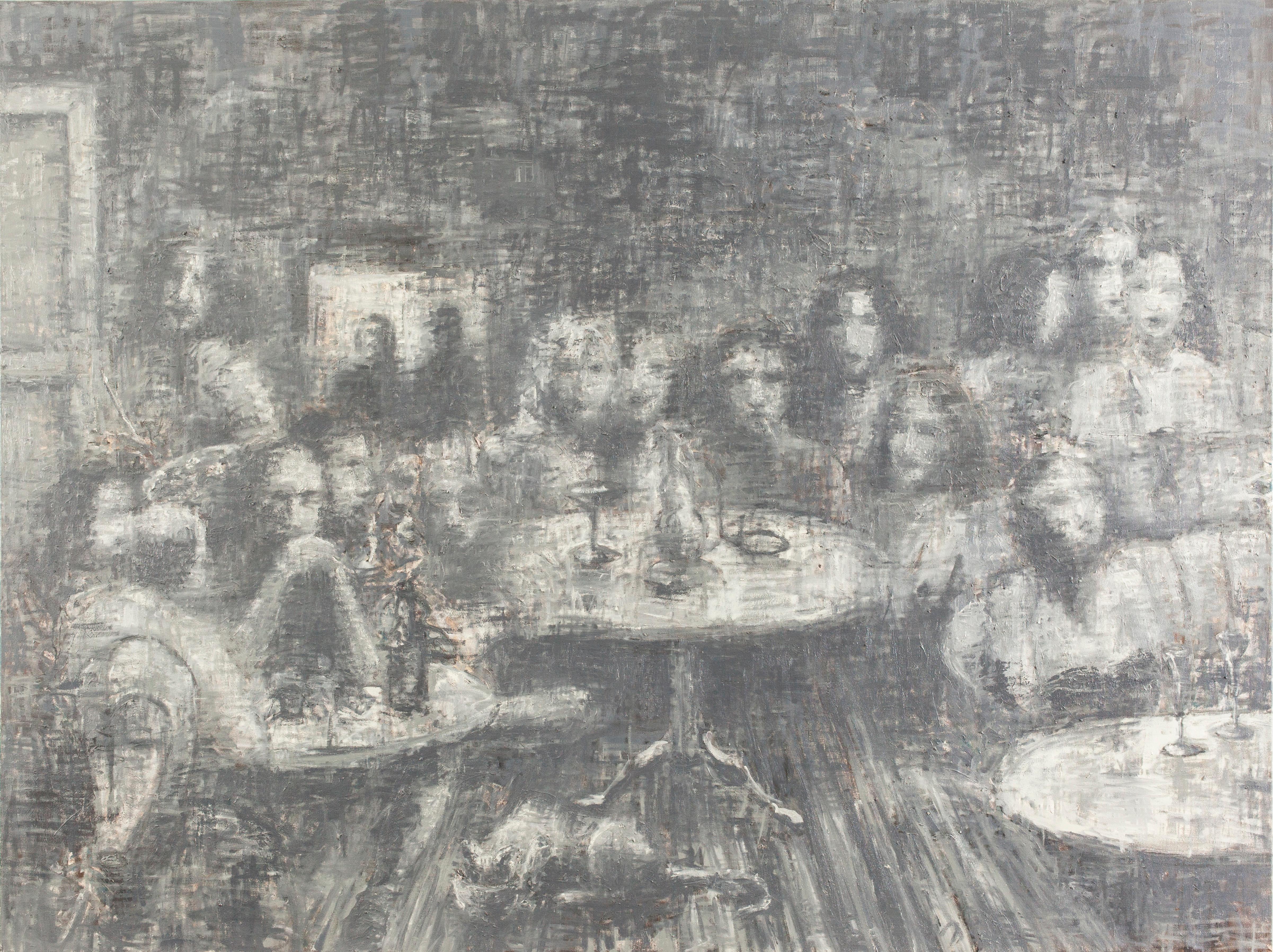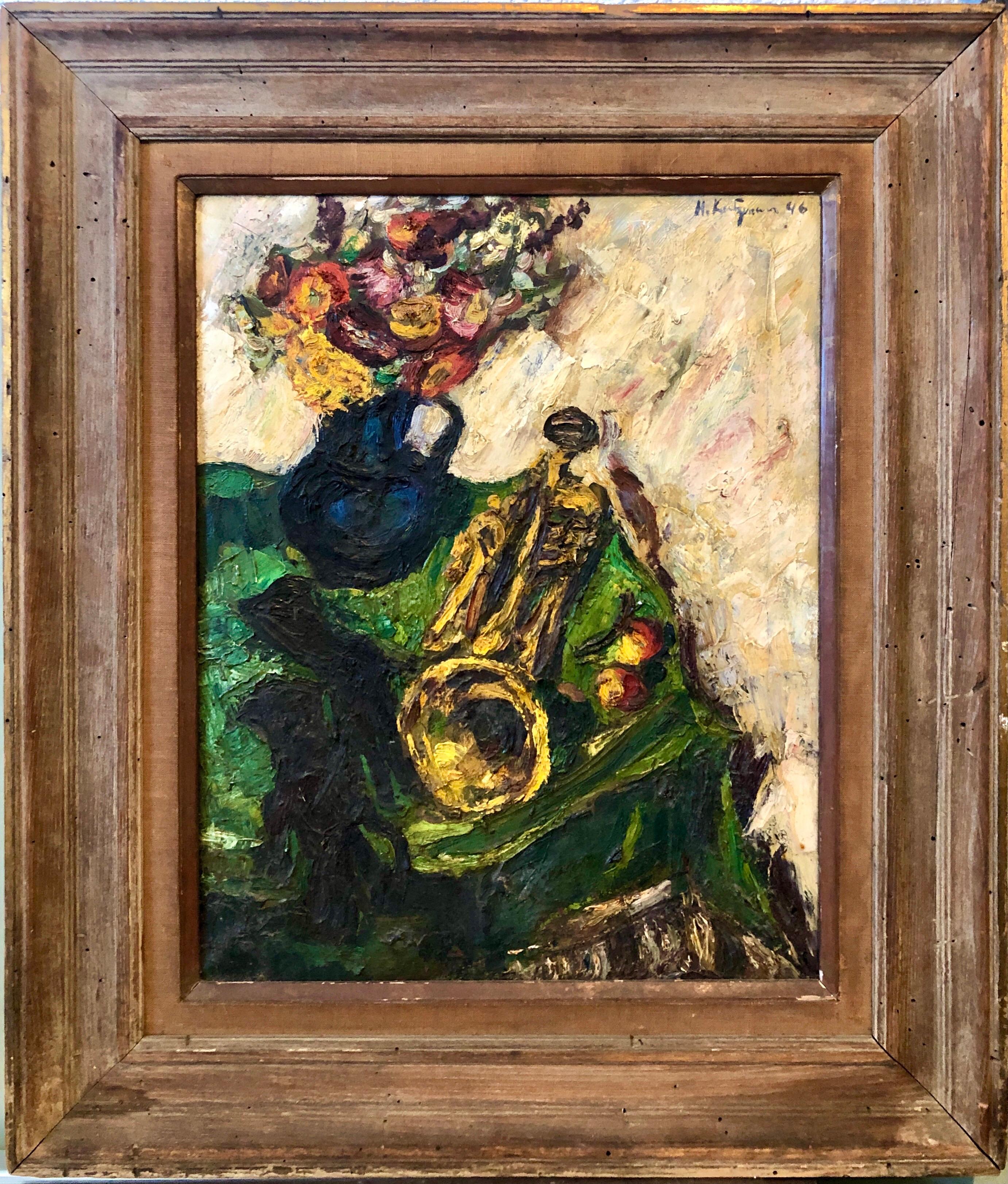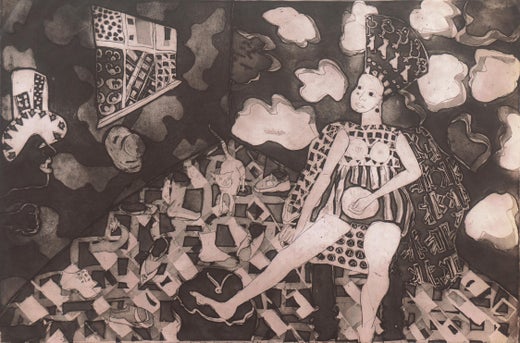Items Similar to Conversation in the Theater - Expressionist Figurative Abstract
Want more images or videos?
Request additional images or videos from the seller
1 of 9
Jane Voitle MellinConversation in the Theater - Expressionist Figurative Abstract 1975
1975
About the Item
Bold and expressive large scale figurative abstract painting of two people conversing in a theater, with a silhouette of a third figure in the foreground, by Jane Voitle Mellin (American, b. 1954), circa 1990. Signed on verso, and on the original stretcher (pictured). Unframed. Image size: 48"H x 49"W
A North Carolina and San Francisco bay area artist. Bachelor of Fine Art University of North Carolina at Chapel Hill.
- Creator:Jane Voitle Mellin (1952)
- Creation Year:1975
- Dimensions:Height: 48 in (121.92 cm)Width: 49 in (124.46 cm)Depth: 1.5 in (3.81 cm)
- Medium:
- Movement & Style:
- Period:
- Condition:
- Gallery Location:Soquel, CA
- Reference Number:
Jane Voitle Mellin
Jane Voitle Mellin is a North Carolina and San Francisco Bay Area artist. He holds a bachelor’s degree in fine arts from the University of North Carolina at Chapel Hill.
About the Seller
4.9
Platinum Seller
These expertly vetted sellers are 1stDibs' most experienced sellers and are rated highest by our customers.
Established in 1986
1stDibs seller since 2014
2,523 sales on 1stDibs
Typical response time: <1 hour
- ShippingRetrieving quote...Ships From: Soquel, CA
- Return PolicyA return for this item may be initiated within 14 days of delivery.
More From This SellerView All
- Dreaming in Color, Expressionist Reclining Female FigureLocated in Soquel, CAA vivid, multicolored expressionist depiction of a gracefully reclining female figure by Bay Area artist Rick Rodrigues (American, 20th Century). Signed with the artist's symbol lowe...Category
1980s Expressionist Figurative Paintings
MaterialsOil, Canvas
- Mid Century Portrait Charlotte with FlowersBy Irina Belotelkin RoublonLocated in Soquel, CAWonderful mid century portrait of woman named Charlotte by Irinia Belotelkin Roublon (Russian/American, 1913 - 2009), circa 1960. Signed lower right corner and on verso. Unframed. Image size: 14"H x 11"W. Irina Belotelkin Roublon, née Roudakoff, was born in Elisavetgrad, Ukraine to the Russian noblesse ancienne, descendant of Catherine the Great, she was a student at the Mariinsky Noble Ladies' Institute , Novocherkassk, Russia. She was orphaned at the time of the Russian Civil War after her father, General Paul Roudakoff, was fatally wounded in battle; 5 days later her mother died of typhus. Still unaware of her parents' death, and after witnessing her two sisters' deaths from starvation, the young Irina, then 8 years old, made her way over 1,000 kilometers, alone and through many privations to Moscow and the Estonian embassy there, with whom her Estonian uncle Volodya Blonsky had made arrangements. After a year in Moscow, and appeals to the Estonian consul, Irina was aided in a dramatic escape from the Soviet Union, to her aunt Anna Blonsky Lassburg (1882–1940) and her husband Doctor Genrick Lassburg in Tallinn, Estonia. Eventually, after in 1929, traveling through Ellis Island and admitted as a student, of voice studies, she joined her brother who had settled, in 1923, in the United States. Irina came to San Francisco during the Second World War, Among Irina's devotions were ballet and opera. She often entertained friends Rudolf Nureyev, Mikhail Baryshnikov, and Sergei Leiferkus when they were in town. Natalia Makarova and Yuri Possokhov were often guests at Irina's Russian Christmas and Easter parties. From the early 1960s through the late 1980s, Irina studied and prolifically created still life and portrait paintings in oil and water color, excelling in flower compositions. She held studio and feature exhibitions; she competed and won prizes. Her work is in holdings throughout the San Francisco Bay area, Europe and Russia. In 1965 she undertook private study with two prominent Russian painters, including Serge Ivanoff; she executed a portrait of her two masters. She cherished her portrait as executed by Serge Ivanoff. Among her most accomplished pieces are those of iris and the large white Matilija...Category
1960s American Impressionist Figurative Paintings
MaterialsCanvas, Oil
- Woman with Two Children in Red - Dutch Style Interior Scene in Oil on CanvasBy Joseph TomanekLocated in Soquel, CAWoman with Two Children in Red - Interior Scene in Oil on Canvas Lovely interior scene by notable artist Joseph Tomanek (Cech-American, 1889-1974). A woman sits near a window, holding a small child dressed in bright red in her lap. Another child, somewhat older, stands next to her, looking at the young child. Soft lights spills though the window, illuminating the scene in a warm glow. A plant with red flowers sits on the windowsill, and foliage can be seen outside. Signed "Tomanek" in the lower right corner (note that the shape above the signature is a toy train) Presented in a carved wood frame with a linen liner. Frame size: 30.75"H x 26.75"W Canvas size: 24"H x 20"W Tomanek, the son of a carpenter, was born in Moravia. His family discouraged his art talent and wanted him to be a shoemaker. He studied in his homeland of Czechoslovakia at the School of Design in Prague. He emigrated to America around the turn of the century and arrived in Chicago in 1910 and worked as an interior decorator. He attended the Art Institute of Chicago and studied with Antonin Sterba. He also studied with Albert Krehbiel and K.A. Buehr. He was a member of the Bohemian Artist Club, Association of Chicago Painters, and Sculptors, and the Chicago Gallery Association. His work is included in the collection of the Vanderpoel Art Association (Chicago). He exhibited from the 1910s-40s, including exhibitions at the Art Institute of Chicago and the Georgia Museum of Art. Of the difficulty of posing nudes in Chicago, he said, "In Paris you can rent little gardens studios and pose your models there in privacy. Here, if I work out of doors, I have to pose the girls in bathing suits...Category
1920s Romantic Figurative Paintings
MaterialsCanvas, Oil
- "Madam Suburbia" (Woman and Baby by the Yellow Window) in Oil on CanvasBy Patricia Gren HayesLocated in Soquel, CA"Madam Suburbia" (Woman and Baby by the Yellow Window) in Oil on Canvas An auburn-haired woman sits in a chair with her infant child, by American painter, Patricia Gren Hayes (b. 19...Category
Mid-20th Century American Modern Figurative Paintings
MaterialsOil, Canvas
- Mother and Daughter Arranging Daffodils in a Vase - Oil on CanvasLocated in Soquel, CAMother and Daughter Arranging Daffodils in a Vase - Oil on Canvas Charming depiction of a mother and daughter with daffodils by Lois Amelia Budlong-Phillips (American, 1857-1932). A...Category
Early 20th Century American Impressionist Figurative Paintings
MaterialsCanvas, Oil, Wood Panel
- "Rosemary" with feather boa - Bay Area Figurative Movement Study Oil on CanvasBy Patricia Gren HayesLocated in Soquel, CA"Rosemary" with feather boa - Bay Area Figurative Movement Study Oil on Canvas A dark-haired woman with a feather boa sits propped on a stool surrounded by bright textures and patte...Category
Mid-20th Century American Modern Figurative Paintings
MaterialsCanvas, Oil
You May Also Like
- Large Expressionist Oil on Canvas, Apartment Interior and Cityscape.By Ernst Ludwig KirchnerLocated in Cotignac, FRA mid century Expressionist oil on canvas of a man, child and cat in an interior with a cityscape beyond. The work is not signed but there are various notations to the top rear stret...Category
Mid-20th Century Expressionist Figurative Paintings
MaterialsOil, Canvas
- Beyond the LimitsLocated in Ibadan, OyoBeyond the Limits is a work that explains what youth in a developing country goes through. Most youth who have to experience the squalor of a developing economy are characterized by wholesale dejection and despair with many of them resorting to drug use and various crimes that jeopardized their lives. Many cannot see a future beyond their present abode. Artist Busari Adewale...Category
21st Century and Contemporary Expressionist Figurative Paintings
MaterialsOil, Acrylic, Canvas
- Paul Manes - Palaz of the Hoon, Painting 2008By Paul ManesLocated in Greenwich, CTPaul Manes was born May 4, 1948, in Austin, Texas. He began his professional career in New York City in the early 1980s. His art has been widely exhibited in America and Europe and h...Category
Early 2000s Expressionist Figurative Paintings
MaterialsCanvas, Paint, Oil
- 1950's Expressionist Interior Oil Painting Still Life with Flowers and TrumpetBy Herbert KatzmanLocated in Surfside, FLHerbert Katzman 1923-2004 (American artist active in New york, Illinois and Italy) Oil Painting Dated 1946. Signed. Dimensions; Sight-16" x 20", Frame-23.5" x 27". Provenance: this bears an old stamp verso from Christie's auction house. Herbert Katzman was born in Chicago on Jan. 8, 1923, His father believing that discipline was a good teacher, sent Herbert and Bob to St. John's military academy for their elementary education but it wasn't long before Herbert found his way to the Art Institute of Chicago where he wanted to study sculpting. His Father vehemently objected and refused to finance his studies, but that wasn't enough to discourage the young artist. He put himself through school working as a student janitor and a few other odd jobs. At 17 he entered the Advanced School of the Art Institute, his interest having turned to painting. His study there was briefly interrupted by a short stint in the navy (1942-44). After receiving a medical discharge, he returned to Chicago to work with Boris Anisfeld, who introduced him to German and French Expressionism...Category
Mid-20th Century Expressionist Figurative Paintings
MaterialsOil, Canvas
- Polish French Jewish Artist Oil Painting Girl with Doll, School of Paris JudaicaBy Walter SpitzerLocated in Surfside, FLFramed 27 X 24 inches Sight 18 X 15 inches Walter Spitzer (Polish/French, 1927 - ) born in Cieszyn, Poland. A Polish Jewish Holocaust survivor, he made his first drawings in a concentration camp. Walter Spitzer has lived and worked since WWII in France, where he studied at the École des Beaux Arts in Paris. Walter Spitzer has achieved great renown as a painter and printmaker. Whether in his paintings of Biblical subjects or in lithographs of Shtetl scenes, His humanity was inspired by the writings of Sartre, Montherlant and Kazantzakis, Walter Spitzer is occupied with two great, interlinked themes: man’s inhumanity to man, and the humanity of man. He will surely be recognized in the future as one of the great witnesses to the twentieth-century experience. Walter Spitzer was born in Chieszyn, Poland, the son of a Jewish liqueur producer, and attended the German school there. He began to draw and paint at an early age. In 1939 the Spitzer family was forcibly removed by the Germans to the town of Strzemieszyce, which was turned into a ghetto in 1942. When the ghetto was liquidated in June 1943 Spitzer’s mother was shot, and the sixteen-year-old Walter was deported to Blechhammer, a subcamp of Auschwitz. There he painted portraits of Wehrmacht soldiers and fellow inmates in exchange for food. He was one of the few to survive the evacuation march from Auschwitz to Buchenwald, where to begin with, in late February 1945, he was held in the Little Camp. To enable him to make drawings documenting life in the camp, the Communists organized his transfer to the main camp. While on a death march in early April he made his escape in the vicinity of Jena and was soon in the hands of the Americans. Spitzer served as an interpreter with an American army unit, and at the same time executed numerous drawings depicting the world of the camps. In June 1945 the Americans took him to Paris, where – following the advice of his father, who had died in 1940 – he began to study art at the École des Beaux-Arts in Par the following year. After completing his training as an artist he produced paintings expressing a critical view of the society of his day. In 1955, in commemoration of the camps and the death marches, he executed a cycle of nine etchings in an edition of thirty, which he gave to various museums in Israel and in France. In the 1960s he established himself as an illustrator of exclusive editions of works by such authors as André Malraux, Jean-Paul Sartre, Joseph Kessel and Nikos Kazantzakis. The Six-Day War prompted him to begin painting subjects from Jewish and Biblical history; At age 19, he was asked to make the scenery for the Edouard VII Theater in Paris, which was showing The Dibbuk of Ansky. In 1947 the same theater asked him to make the scenery for the Hill of Life ( Max Zveig). Spitzer has been a member of the Salon d'Automne since 1952. He was the last remaining survivor of the Montparnasse Ecole de Paris. A group of Jewish expats that included Issachar Ber Ryback, Abel Pann, Abraham Mintchine, Isaac Antcher, Alexandre Altmann, Henri Epstein, Mane Katz, Marcel Janco, Gregoire Michonze...Category
1960s Expressionist Figurative Paintings
MaterialsCanvas, Oil
- Large French Expressionist Oil Painting, Girl, Poupèe, the Doll, Ecole de ParisLocated in Surfside, FLSigned on recto and signed verso, titled, and inscribed Montmartre by the artist. This is a large colorful expressionist painting of a girl doll with long blonde or ginger redhead pigtails. It is titled Poupee 1925 and depicts an Art Deco era flapper girl in a beret. Roger Crusat (French Expressionist artist, poet and lithographer) is known for ballet troupe set design and theatre backdrop painting and architectural motifs. Roger Crusat was born in 1917 in Roussillon, Provence, France. Crusat's early works depict the colorful countryside of Provence in the South of France, As a young man Crusat performed many jobs in the troupe, designing costumes, and even dancing. But, most important, he painted the scenery for the troupe's performances. It was while working in this capacity that he learned the essentials of scenery painting that remain evident in his mature work. Crusat was a student of Andre Fons-Godail at Beaux-Arts in Perpignan when he was called to serve in World War II. After being wounded in 1940, he returned to study under Rene Jaudon at Beaux-Arts in Paris. Crusat was known by his contemporaries as "the Catalan painter of Montmartre" where he lived with his wife until his death in 1994. Cracked and peeling walls framed by rusting water pipes are a common sight in Montmartre. What others considered unnecessary, Crusat included. Water pipes were his cherished motif. Supposed by some to be a symbol of decay and monotony, Crusat's Impressionist water pipes like arteries in the body, convey life. Crusat won the prestigious Prix Populiste for his "Descente d'Eau" (Water Pipes) in 1956. Crusat's mature work retains the essentials of good scenery painting. Intricate detail will not be found, but broad, solid abstract shapes abound. His subtle colors, dense in texture, are meant to compliment his subjects, not distract from them. The critics considered him a lyric expressionist and a "painter of Man" in his portrayal of the anguish of daily life and the regrets of the past. Crusat exhibited at many of the same Salons as the post-impressionists and expressionists. Salon des Independants was co-founded by Georges Seurat. Degas had only one exhibition during his lifetime, and it was at the Galerie Durand Ruel in Paris. Gauguin had also exhibited his Tahitian paintings. Crusat's works were exhibited there in 1955. SELECT AWARDS 1954 Le Prix de la Jeune Peintre 1955 Prix des Amateurs d'Art & des Collectionneurs, Galerie Gazette des Beaux Arts, 140 rue Faubourg St. Honore, Paris Les Jardins des Abbesses purchased by the Republic of France, Prix de la Ville de Marseilles, Prix Othon Friesz 1956 Prix Populiste, Prix de Amedeo Modigliani 1957 Grand Prix International de Vichy, Prix de la Fondation Greenshields 1959 IVeme Grand Prix de Peinture du Festival de Vichy 1967 Le Prix des Amis de Brantôme, Perigord, France 1970 Prix de la Critique Academy de Vernet a Vichy,"La Nuit, Premiere Etude" Roger Crusat, Half-closed shutters , poems enriched with four original lithographs (175 numbered copies) drawn on Henri Deprest's presses on February 13, 1975 , Éditions Matignon 34, 1975. Personal exhibitions Durand-Ruel Gallery, Paris, 1955 [ 1 ] . Galerie Rivière, Paris, november 1958 [ 4 ] . Le Roux and Mathias, auctioneers in Paris, Sale of the Roger Crusat workshop , Hôtel Drouot , Paris, Thursday October 27, 1994 [ 5 ] . Jack's American Bistro, Glens Falls , September- october 2004 [ 6 ] . Collective exhibitions Galerie Roger, Lyon , October 1946 [ 7 ] . Salon des Indépendants , Paris, from 1952 [ 8 ] . Exhibition Discover , Galerie Charpentier , Paris, 1955. Populist Salon, Paris, 1956. Salon des Amis de Brantôme, 1957. Hundred painters and oil - Exhibition on the occasion of the centenary of the first oil drilling , Musée Galliera , october 1958 [ 9 ] . “An artist from Roussillon whose invoice calls for a flattering comparison with that of a Soutine or a Rebeyrolle . Indeed, following their example, he focuses on familiar scenes: Girls on the balcony or in the basket , Laundresses weighing heavily on the iron, draft horses or plucked turkeys, who stand next to a magnificent portrait of a man in a red dressing gown . Hasn't the Prix Populiste already crowned its merits? " - Jean Jacquinot SELECT EXHIBITIONS Galerie La Gentilhommiere, Paris La Salle Arago, Perpignan, Salon des Indépendants, Salon d'Automne Biennale de Menton, Menton Galerie des Jacobins, Lyon Galerie Durand-Ruel, Paris Salon de la Nationale Galerie Bassano, Paris Salon Populiste Salon de Romans Galerie Motte, Geneva, Switzerland Exposition à Quiberville sur Mer - Normandie Galerie Charpentier Salon Confrontation: Bernard Buffet, Roger Crusat, Jean Jansem, Franck Innocent, Jean-Jacques Morvan...Category
Mid-20th Century Expressionist Figurative Paintings
MaterialsCanvas, Oil






